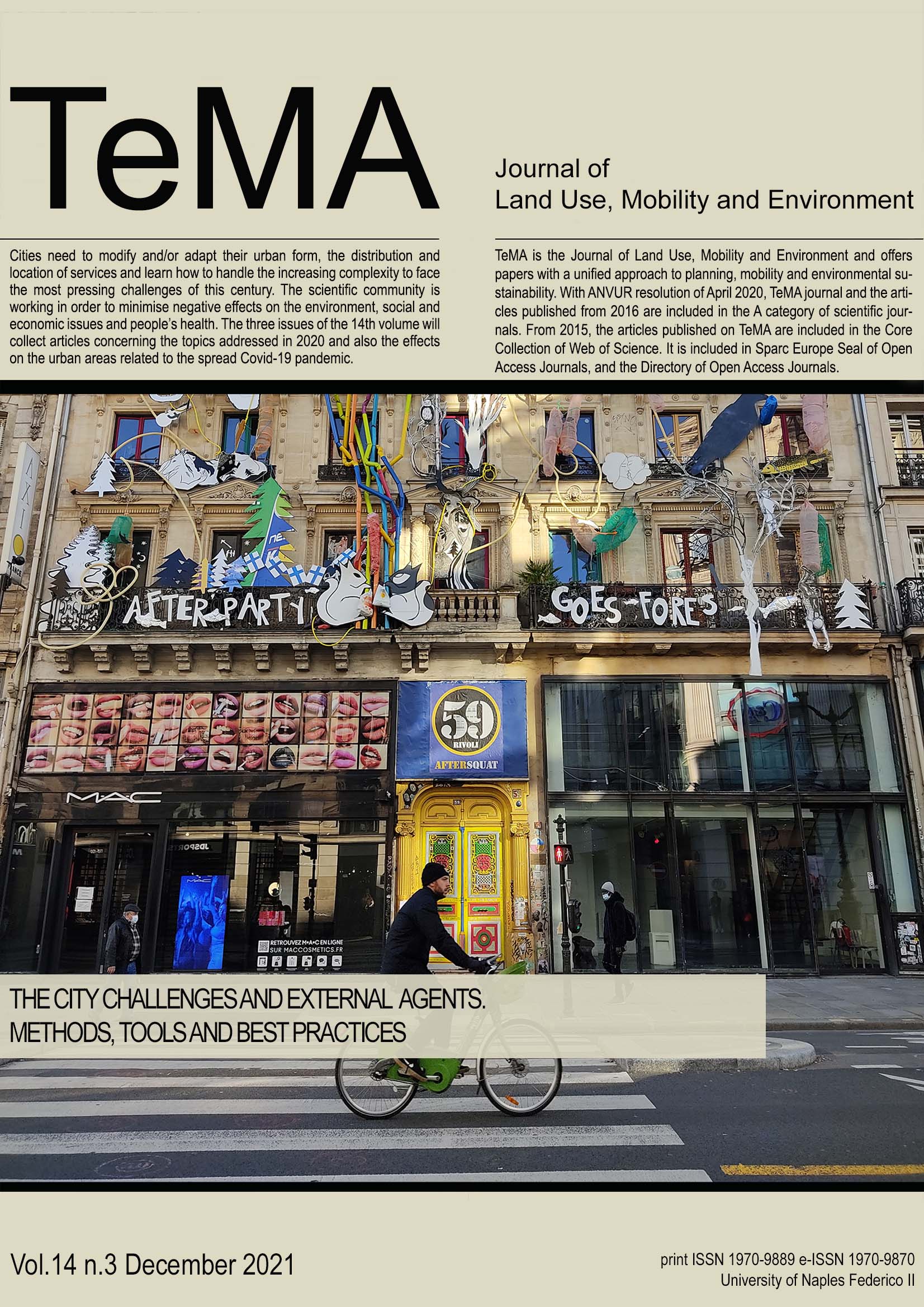Resilience as an urban strategy: a comparison of resources and interventions in the European Recovery Plans for the green transition
Abstract
Starting from the relationship between urban planning and mobility management, TeMA has gradually expanded the view of the covered topics, always following a rigorous scientific in-depth analysis. This section of the Journal, Review Notes, is a continuous update about emerging topics concerning relationships among urban planning, mobility, and environment, thanks to a collection of short scientific papers written by young researchers. The Review Notes are made up of five parts. Each section examines a specific aspect of the broader information storage within the main interests of the TeMA Journal. In particular: the Town Planning International Rules and Legislation. Section aims at presenting the latest updates in the territorial and urban legislative sphere. The ecological transition is one of the most important missions within the recovery and resilience plans that aim towards an increasingly sustainable city model. The reference scientific literature highlights the importance of studying the relationships between energy policy and the physical-functional organization of urban systems. In this direction, the content of this review aims to define the framework of the interventions and resources in the resilience and recovery plans of two European states of Spain and Ireland. We review their ecological and green revolution/transition reforms in a comparative study to Italy and Germany. The aim is to define the role and impacts of these reforms in future urban strategies.
Downloads
References
Ania, A. E. D., & Joseph, A. A. (2021). COVID-19 and Africa's aviation and tourism sectors: A new agenda for the future?. Tourism Management Perspectives, 100840. https://doi.org/10.1016/j.tmp.2021.100840
Bridge, G., & Gailing, L. (2020). New energy spaces: Towards a geographical political economy of energy transition. Environment and Planning A: Economy and Space, 52 (6), 1037-1050. https://doi.org/10.1177/0308518X20939570
European Commission (2021). Economic Forecast: From recovery to expansion, amid headwinds. Retrieved from: https://ec.europa.eu/info/business-economy-euro/economic-performance-and-forecasts/economic-forecasts/autumn-2021-economic-forecast_en
Gaglione, F., & Ayiine-Etigo, D. A. (2021). Resilience as an urban strategy: The role of green interventions in recovery plans. TeMA - Journal of Land Use, Mobility and Environment, 14(2), 279-284. https://doi.org/10.6093/1970-9870/8054
Gargiulo, C., & Papa, R. (2021). Chaos and chaos: the city as a complex phenomenon. TeMA - Journal of Land Use, Mobility and Environment, 14(2), 261-270. https://doi.org/10.6093/1970-9870/8273
Gargiulo, C., & Russo, L. (2017). Cities and energy consumption: a critical review. TeMA-Journal of Land Use, Mobility and Environment, 10(3), 259-278. https://doi.org/10.6092/1970-9870/5182
Hanif, I. (2018). Impact of fossil fuels energy consumption, energy policies, and urban sprawl on carbon emissions in East Asia and the Pacific: A panel investigation. Energy strategy reviews, 21, 16-24. https://doi.org/10.1016/j.esr.2018.04.006
Ireland's National Recovery and Resilience Plan (2021). Retrieved from: https://www.gov.ie/en/publication/d4939-national-recovery-and-resilience-plan-2021/
Istat, Rapporto annuale (2021). La situazione del Paese. Retrieved from: https://www.istat.it/it/archivio/258983
Mauree, D., Coccolo, S., Perera, A. T. D., Nik, V., Scartezzini, J. L., & Naboni, E. (2018). A new framework to evaluate urban design using urban microclimatic modeling in future climatic conditions. Sustainability, 10(4), 1134. https://doi.org/10.3390/su10041134
Navamuel, E. L., Morollón, F. R., & Cuartas, B. M. (2018). Energy consumption and urban sprawl: Evidence for the Spanish case. Journal of cleaner production, 172, 3479-3486. https://doi.org/10.1016/j.jclepro.2017.08.110
Oke, T. R. (1981). Canyon geometry and the nocturnal urban heat island: comparison of scale model and field observations. Journal of climatology, 1(3), 237-254. https://doi.org/10.1002/joc.3370010304
Plan de recuperación, transformacion y resiliencia (2021). Retrieved from: https://www.lamoncloa.gob.es/temas/fondos-recuperacion/Documents/30042021-Plan_Recuperacion_%20Transformacion_%20Resiliencia.pdf
Pushkarev, B. (1975). The Costs of Sprawl: Environmental and Economic Costs of Residential Development Patterns at the Urban Fringe. Vol. I, Detailed Cost Analysis, Vol. II, Literature Review and Bibliography, Vol. III, Executive Summary. Retrivied from: https://www.jstor.org/stable/24112364
Raydan, D., & Steemers, K. (2013). Environmental urban design. In Environmental Design of Urban Buildings (pp. 25-59). Routledge. https://doi.org/10.4324/9781849771160
Trepci, E., Maghelal., P., & Azar, E. (2020). Effect of densification and compactness on urban building energy consumption: Case of a Transit-Oriented Development in Dallas, TX. Sustainable Cities and Society, 56, 101987. https://doi.org/10.1016/j.scs.2019.101987
Zecca, C., Gaglione, F., Laing, R., & Gargiulo, C. (2020). Pedestrian routes and accessibility to urban services: an urban rhythmic analysis on people's behaviour before and during the COVID-19. TeMA: journal of land use, mobility and environment, 13(2). https://doi.org/10.6092/1970-9870/7051
Copyright (c) 2021 TeMA - Journal of Land Use, Mobility and Environment

This work is licensed under a Creative Commons Attribution 4.0 International License.
Authors who publish in this journal agree to the following:
1. Authors retain the rights to their work and give in to the journal the right of first publication of the work simultaneously licensed under a Creative Commons License - Attribution that allows others to share the work indicating the authorship and the initial publication in this journal.
2. Authors can adhere to other agreements of non-exclusive license for the distribution of the published version of the work (ex. To deposit it in an institutional repository or to publish it in a monography), provided to indicate that the document was first published in this journal.
3. Authors can distribute their work online (ex. In institutional repositories or in their website) prior to and during the submission process, as it can lead to productive exchanges and it can increase the quotations of the published work (See The Effect of Open Access)

